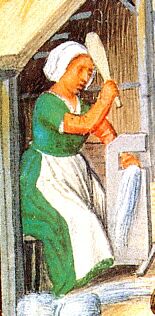Well I'm starting my first dress diary ever. With the aid of my somewhat less than trusty digital camera (it's big clumsy and produces relatively blurry pictures but it works and I got it third hand for free) I will try to document my progress as I make my new Tudor Kirtle. This project has been lurking in the back of my mind for a long time. Discussions with other costumers, a bit of research and a bit of experimentation has led me to the conclusion that a kirtle (i.e. the middle layer between the smock and the gown) stiffened with canvas and boning would be far more convenient than my current corset and petticoat. So, taking inspiration from the petticoat bodies Eleanora di Toledo (in Janet Arnold's Patterns of Fashion) used in place of a corset I decided to make a kirtle which could be worn either on its own or underneath another gown. I had been planning to make a complete Tudor from the skin out to use up some of the fabric lying around in my cupboard. When I heard that a couple from my Barony (TRH Stephen & Mathilde, Crown Prince and Princess of Lochac) were going to become the next King and Queen of Lochac, I made up my mind that I would go to twelfth night to see their coronation (I had been debating for a while whether or not I would make the trip). I realised that I needed a new set of summer weight court garb so this was the perfect opportunity to make a complete outfit not just the gown. |
|
| I am basing my
kirtle on those worn by the women in Simon Bening's
DaCosta Hours. As soon as I saw Hope Greenberg's site on
the clothing of working class men and women I realised
how perfect this style of kirtle would be for wearing
beneath a Tudor gown. In the picture to the right you can see the woman is wearing a short sleeved green kirtle with detatchable orange lower sleeves. You can clearly see the gap between the attached kirtle sleeve and the detatchable lower sleeves with the smock poking through. This shows that we are not looking at a short sleeved dress worn over another long sleeved dress and that these sleeves are not permanently sewn on to the kirtle. |
 Simon Bening c. 1510. Detail from the month of November. |



